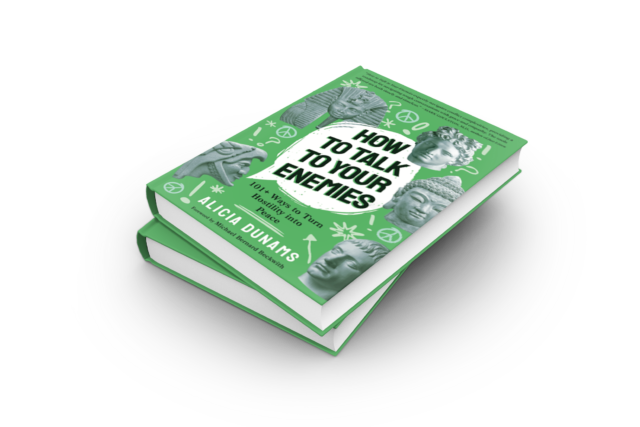We are thrilled to introduce Alicia Dunams as our guest writer this month, featuring her new book, How to Talk To Your Enemies: 101+ Ways to Turn Hostility Into Peace, now available on Amazon. Alicia has embarked on an inspiring campaign to provide a copy of her book to every member of Congress. To learn more about her mission and show your support, click here. Below is an excerpt from her book:
“Peace is not the absence of conflict but the presence of creative alternatives for responding to conflict.”
— Dorothy Thompson, journalist and radio commentator
As someone who has taught mediation in the workplace and mediated business conflicts, I strongly believe that participating in mediation can be one of the most powerful skill-building and transformational experiences. This is because it requires individuals to approach conflicts with humility and without attachment to being right.
Leaders and managers will eventually face conflicts in the workplace — they’re inevitable. Yet conflict does not have to be a negative experience. Luke Roberts, a conflict resolution expert, believes that conflict is an opportunity for negotiation and the creation of new ideas. “Conflict is good in the negotiation process. It’s the clash of two ideas, which then, all being well, produces a third idea,” says Roberts.
Mediation is an effective way to resolve a work conflict. Here are some steps for a third party, perhaps a manager or colleague of the two conflicting parties, to facilitate a workplace mediation. (You also can use these steps one-on-one if you do not have a mediator.)
- Acknowledge the conflict. Conflicts should be addressed directly, rather than ignored or swept under the rug.
- Gain the commitment of both parties to finding a solution. Both parties should be committed to finding a solution before mediation begins. Let the other person know that you are committed to finding a solution.
- Set ground rules. Agree on ground rules, such as using “I” statements over “You” statements, focusing on behaviors and issues, and listening to each person’s perspective without personal attacks.
- Ask questions to solicit, question, clarify, and encourage. Gather information by using open-ended questions and listening to each person’s perspective. Do this without judgment and keep the tone neutral.
- Soliciting: “Would you both like to have some discussion on…?”
- Questioning: “Can you tell me when and where that happened?”
- Clarifying: “Could you/Please describe in more detail what happened/the issue?”
- Encouraging: “I’m interested in that. I would like to hear more about […]?
- Summarize what you heard. Repeat back what was said to ensure everyone understands each other’s perspectives. “What I hear you saying is… Do I have it correct?”
- Find areas of agreement. Look for common ground and areas of mutual understanding.
- Brainstorm a mutually beneficial solution. Collaborate with both parties to come up with a solution that benefits everyone. Try a SMART solution. SMART is an acronym for specific, measurable, atta
inable, relevant and timebound. - Set up a check-in schedule and deadline. Ensure that both parties are committed to implementing the solution and monitoring progress.

Mindful Communication Responses
Three vital questions for workplace mediators…
1. The Interest-seeking question: Helps establish the foundational interests and needs of a person. Can you tell me why that is important to you?
2.The Party-Echo Question: Establishes mutual understanding. Could you repeat back what you heard [NAME] say?
3. The Discussion Invitation Question: Initiates parties into a discussion. Would you both like to talk about [topic]?




